J1 League
| Organising body | J.League |
|---|---|
| Founded | 1992 |
| Country | Japan |
| Confederation | AFC |
| Number of teams | 20 |
| Level on pyramid | 1 |
| Relegation to | J2 League |
| Domestic cup(s) | Emperor's Cup Fuji Xerox Super Cup |
| League cup(s) | YBC Levain Cup |
| International cup(s) | AFC Champions League |
| Current champions | Kawasaki Frontale (3rd title) (2020) |
| Most championships | Kashima Antlers (8 titles) |
| Top goalscorer | Yoshito Ōkubo (179 goals) |
| TV partners | DAZN (Japan only) NHK YouTube (outside Japan) |
| Website | www.jleague.jp/en/ |
| Current: 2021 J1 League | |
The J1 League (Japanese: J1リーグ, Hepburn: Jē-wan Rīgu) or simply J1 is the top division of the Japan Professional Football League (日本プロサッカーリーグ, Nihon Puro Sakkā Rīgu) and the top professional Football J.League in Japan.[2][3][4][5][6][7][8] It is one of the most successful leagues in Asian club football. Currently, the J1 League is the first level of the Japanese association football league system. The second tier is represented by the J2 League. It is currently sponsored by Meiji Yasuda Life and thus officially known as the Meiji Yasuda J1 League (Japanese: 明治安田生命J1リーグ).[9] Until the 2014 season it was named the J.League Division 1.
History[]
Phases of J1[]
Before the professional league (1992 and earlier)[]
Before the inception of the J.League, the highest level of club football was the Japan Soccer League (JSL), which consisted of amateur clubs.[10][11] Despite being well-attended during the boom of the late 1960s and early 1970s (when Japan's national team won the bronze Olympic medal at the 1968 games in Mexico), the JSL went into decline in the 1980s, in general line with the deteriorating situation worldwide. Fans were few, the grounds were not of the highest quality, and the Japanese national team was not on a par with the Asian powerhouses. To raise the level of play domestically, to attempt to garner more fans, and to strengthen the national team, the Japan Football Association (JFA) decided to form a professional league.
The professional association football league, J.League was formed in 1992, with eight clubs drawn from the JSL First Division, one from the Second Division, and the newly formed Shimizu S-Pulse. At the same time, JSL changed its name and became the former Japan Football League, a semi-professional league. Although the J.League did not officially launch until 1993, the Yamazaki Nabisco Cup competition was held between the ten clubs in 1992 to prepare for the inaugural season.
Inaugural season and J.League boom (1993–1995)[]
J.League officially kicked off its first season with ten clubs in early 1993.
After the boom (1996–1999)[]
Despite the success in the first three years, in early 1996 the league attendance declined rapidly. In 1997 the average attendance was 10,131, compared to more than 19,000 in 1994. Notably, Arsene Wenger managed Nagoya Grampus Eight during this period.
Change of infrastructure and game formats (1999–2004)[]
The league's management finally realized that they were heading in the wrong direction. In order to solve the problem, the management came out with two solutions.
First, they announced the J.League Hundred Year Vision, in which they aim to make 100 professional association football clubs in the nation of Japan by 2092, the hundredth season. The league also encouraged the clubs to promote football or non-football related sports and health activities, to acquire local sponsorships, and to build good relationship with their hometowns at the grass-root level. The league believed that this will allow the clubs to bond with their respective cities and towns and get support from local government, companies, and citizens. In other words, clubs will be able to rely on the locals, rather than major national sponsors.
Second, the infrastructure of the league was heavily changed in 1999. The league acquired nine clubs from the semi-professional JFL and one club from J.League to create a two division system. The top flight became the J.League Division 1 (J1) with 16 clubs while J.League Division 2 (J2) was launched with ten clubs in 1999. The former second-tier Japan Football League now became the third-tier Japan Football League.
Also, until 2004 (with the exception of 1996 season), the J1 season was divided into two. At the end of each full season, the champion from each half played a two-legged series to determine the overall season winner and runners-up. Júbilo Iwata in 2002, and Yokohama F. Marinos in 2003, won both "halves" of the respective seasons, thus eliminating the need for the playoff series. This was the part of the reason the league abolished the split-season system starting from 2005.
European League Format & AFC Champions League (2005–2008)[]
Since the 2005 season, J.League Division 1 consisted of 18 clubs (from 16 in 2004) and the season format became more similar to European club football. The number of relegated clubs also increased from 2 to 2.5, with the 3rd-to-last club going into the promotion/relegation playoffs with the third-placed J2 club. Since then, other than minor adjustments, the top flight has stayed consistent.
Japanese teams did not treat the AFC Champions League that seriously in the early years, in part due to the distances travelled and teams played. However, in the 2008 Champions League, three Japanese sides made the quarter-finals.[12]
However, in recent years, with the inclusion of the A-League in Eastern Asia, introduction to the Club World Cup, and increased marketability in the Asian continent, both the league and the clubs paid more attention to Asian competition. For example, Kawasaki Frontale built up a notable fan base in Hong Kong, owing to their participation in the Asian Champions League during the 2007 season.[13] Continuous effort led to the success of Urawa Red Diamonds in 2007 and Gamba Osaka in 2008. Thanks to excellent league management and competitiveness in Asian competition, the AFC awarded J.League the highest league ranking and a total of four slots starting from the 2009 season. The league took this as an opportunity to sell TV broadcasting rights to foreign countries, especially in Asia.
Also starting from the 2008 season, the Emperor's Cup Winner was allowed to participate in the upcoming Champions League season, rather than waiting a whole year (i.e. 2005 Emperor's Cup winner, Tokyo Verdy, participated in the 2007 ACL season, instead of the 2006 season). In order to fix this one-year lag issue, the 2007 Emperor's Cup winner, Kashima Antlers' turn was waived. Nonetheless, Kashima Antlers ended up participating in the 2009 ACL season by winning the J.League title in the 2008 season.
Modern phase (2009–2016)[]
Three major changes were seen starting in the 2009 season. First, starting that season, four clubs entered the AFC Champions League. Secondly, the number of relegation slots increased to three. Finally, the AFC Player slot was implemented starting this season. Each club will be allowed to have a total of four foreign players; however, one slot is reserved for a player that derives from an AFC country other than Japan. Also, as a requirement of being a member of the Asian Football Confederation, the J.League Club Licence regulations started in 2012 as one criterion of whether a club was allowed to stay in its division or to be promoted to a higher tier in professional level league. No major changes happened to J.League Division 1 as the number of clubs stayed at 18.
In 2015 the J.League Division 1 was renamed J1 League. Also, the tournament format was changed to a three-stage system. The season was split into first and second stages, followed by a third and final championship stage. The third stage was composed of three to five teams. The top point accumulator in each stage and the top three point accumulators for the overall season qualified. If both of the stage winners finished in the top three teams for the season, then only three teams qualified for the championship stage. These teams then took part in a championship playoff stage to decide the winner of the league trophy.
Future (2017–)[]
Despite the new multi-stage format being initially reported as locked in for five seasons, due to a negative reaction from hardcore fans, and a failure to appeal to casual fans, towards the end of the 2016 it was abandoned in favour of a return to a single-stage system.[14] From 2017, the team which accumulates the most points will be named champion, with no championship stage taking place at the season's end, and from 2018, the bottom two clubs are relegated and the 16th-placed club enters a playoff with the J2 club that wins a promotion playoff series.[15] If the J2 playoff winner prevails, the club is promoted, with the J1 club being relegated, otherwise the J1 club can retain its position in J1 League with the promotion failure of the J2 club.
In November 2017, Urawa Red Diamonds played the AFC Champions League final against Al Hilal. After a draw in the first leg, Urawa Red Diamonds won the second leg 1-0 and were crowned Asian Champions. In the past 10–15 years, Japanese clubs have risen not only continentally, but also internationally. Clubs Gamba Osaka and Urawa Red Diamonds have been crowned Asian champions and participated in the Club World Cup, always targeting at least the semi-finals. Kashima Antlers were finalists of the 2016 edition and eventually lost to Real Madrid.
Timeline[]
| Year | Important events | # J clubs | # ACL clubs | Rele. slots |
|---|---|---|---|---|
| 1989 |
|
|||
| 1990 |
|
|||
| 1992 |
|
|||
| 1993 |
|
10 | ||
| 1994 |
|
12 | ||
| 1995 |
|
14 | ||
| 1996 |
|
16 | ||
| 1997 |
|
17 | ||
| 1998 |
|
18 | ||
| 1999 |
|
16 | 2 | |
| 2000 | 16 | 2 | ||
| 2001 | 16 | 2 | ||
| 2002 | 16 | 2 | 2 | |
| 2003 |
|
16 | 2 | |
| 2004 |
|
16 | 2 | 0.5 |
| 2005 |
|
18 | 2 | 2.5 |
| 2006 |
|
18 | 2 | 2.5 |
| 2007 |
|
18 | 2 | 2.5 |
| 2008 |
|
18 | 2 + 1 | 2.5 |
| 2009 |
|
18 | 4 | 3 |
| 2010 | 18 | 4 | 3 | |
| 2011 |
|
18 | 4 | 3 |
| 2015 |
|
18 | 4 | 3 |
| 2016 |
|
18 | 4 | 3 |
| 2017 |
|
18 | 4 | 3 |
| 2018 |
|
18 | 4 | 2.5 |
| 2019 |
|
18 | 4 | 2.5 |
| 2020 |
|
18 | 3 | 0 |
| 2021 |
|
20 | 3 | 4 |
2021 season[]
League format[]
Eighteen clubs will play in double round-robin (home and away) format, a total of 34 games each. A club receives 3 points for a win, 1 point for a tie, and 0 points for a loss. The clubs are ranked by points, and tiebreakers are, in the following order:
- Goal differential
- Goals scored
- Head-to-head results
- Disciplinary points
A draw would be conducted, if necessary. However, if two clubs are tied for first place, both clubs will be declared as co-champions. The top three clubs will qualify to the following year's AFC Champions League, while the bottom two clubs will be relegated to J2. The third club will play a playoff against the J2 playoffs-winning team.
- Prize money (2020 figures)
- Champions: 300,000,000 yen
- Second place: 120,000,000 yen
- Third place: 60,000,000 yen
In addition to the prize, top 4 clubs are awarded with the following funds.
- J league funds distributed to top 4 clubs (from 2017)
- Champions: 1,550,000,000 yen
- Second place: 700,000,000 yen
- Third place: 350,000,000 yen
- Fourth place: 180,000,000 yen
Participating clubs[]
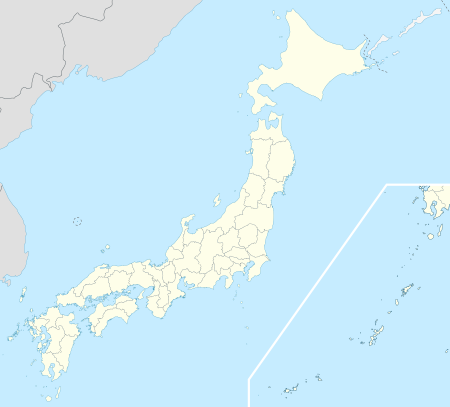
Tosu
Hiroshima
FC Tokyo
Kawasaki Frontale
Urawa Red Diamonds
Shonan Bellmare
Yokohama F. Marinos
Yokohama FC
Kashima Antlers
Kashiwa Reysol
Cerezo Osaka
Gamba Osaka
Vissel Kobe
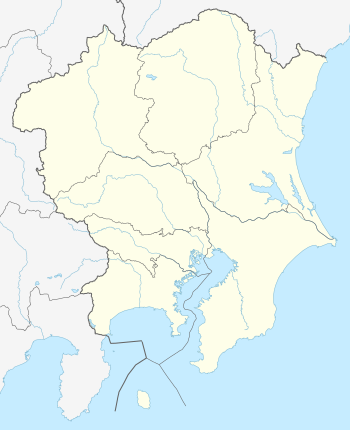

| Club | Year joined |
Seasons in J1 |
Based in | First season in top flight |
Seasons in top flight |
Current spell in top flight |
Last title |
|---|---|---|---|---|---|---|---|
| Kashima Antlers | 1993 | 28 | Southwestern cities/towns of Ibaraki | 1985/86 | 31 | 1993– | 2016 |
| Avispa Fukuoka | 1996 | 9 | Fukuoka, Fukuoka | 1996 | 9 | 2021– | – |
| Shonan Bellmare | 1994 | 13 | South and central cities/town in Kanagawa | 1972 | 31 | 2018– | 1981 |
| Cerezo Osaka | 1995 | 20 | Osaka & Sakai, Osaka | 1965 | 46 | 2017– | 1980 |
| Hokkaido Consadole Sapporo | 1998 | 9 | All cities/towns in Hokkaidō | 1989/90 | 12 | 2017– | – |
| Yokohama F. Marinos | 1993 | 28 | Yokohama, Yokosuka & Yamato | 1979 | 40 | 1982– | 2019 |
| Kawasaki Frontale | 1999 (J2) | 17 | Kawasaki, Kanagawa | 1977 | 19 | 2005– | 2020 |
| Gamba Osaka | 1993 | 27 | North cities in Osaka | 1986/87 | 34 | 2014– | 2014 |
| Nagoya Grampus | 1993 | 27 | All cities/towns in Aichi | 1973 | 35 | 2018– | 2010 |
| Urawa Red Diamonds | 1993 | 27 | Saitama | 1965 | 53 | 2001– | 2006 |
| Kashiwa Reysol | 1995 | 23 | Kashiwa, Chiba | 1965 | 47 | 2020– | 2011 |
| Shimizu S-Pulse | 1993 (J) | 27 | Shizuoka | 1993 | 27 | 2017– | – |
| Sagan Tosu | 1999 (J2) | 9 | Tosu, Saga | 2012 | 9 | 2012– | – |
| Sanfrecce Hiroshima | 1993 | 26 | Hiroshima, Hiroshima | 1965 | 48 | 2009– | 2015 |
| FC Tokyo | 1999 (J2) | 20 | Chofu | 2000 | 20 | 2012– | – |
| Oita Trinita | 1999 (J2) | 10 | All cities/towns in Ōita | 2003 | 10 | 2019– | – |
| Vegalta Sendai | 1999 (J2) | 13 | Sendai, Miyagi | 2002 | 13 | 2010– | – |
| Vissel Kobe | 1997 | 22 | Kobe, Hyōgo | 1997 | 22 | 2014– | – |
| Tokushima Vortis | 2005 (J2) | 1 | All cities/towns in Tokushima | 2014 | 1 | 2021– | – |
| Yokohama FC | 2001 (J2) | 2 | Yokohama, Kanagawa | 2007 | 2 | 2020– | – |
Source for teams participating:[17]
- Pink background denotes club was most recently promoted from J2 League.
- "Year joined" is the year the club joined the J.League (Division 1 unless otherwise indicated).
- "First season in top flight", "Seasons in top flight", "Current spell in top flight", and "Last title" include seasons in the old Japan Soccer League First Division.
Stadiums (2021)[]
Primary venues used in the J1 League:
| Urawa Red Diamonds | Kashima Antlers | Shimizu S-Pulse | Gamba Osaka | Yokohama F. Marinos | Kawasaki Frontale | Shonan Bellmare |
|---|---|---|---|---|---|---|
| Saitama Stadium 2002 | Kashima Soccer Stadium | IAI Stadium Nihondaira | Panasonic Stadium Suita | Nissan Stadium | Kawasaki Todoroki Stadium | Shonan BMW Stadium Hiratsuka |
| Capacity: 63,700 | Capacity: 40,728 | Capacity: 20,339 | Capacity: 40,000 | Capacity: 72,370 | Capacity: 26,000 | Capacity: 15,200 |

|

|

|

|

|

|

|
| Vissel Kobe | Nagoya Grampus | Cerezo Osaka | Kashiwa Reysol | Yokohama FC | ||
| Noevir Stadium Kobe | Paloma Mizuho Stadium | Toyota Stadium | Yanmar Stadium Nagai | Nagai Ball Game Field | Sankyo Frontier Kashiwa Stadium | Nippatsu Mitsuzawa Stadium |
| Capacity: 30,132 | Capacity: 27,000 | Capacity: 45,000 | Capacity: 47,816 | Capacity: 19,904 | Capacity: 15,349 | Capacity: 15,454 |
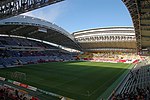
|
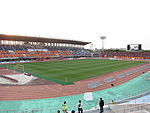
|

|
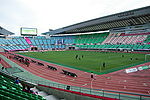
|

|

|
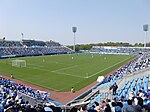
|
| Vegalta Sendai | Consadole Sapporo | Sagan Tosu | FC Tokyo | Oita Trinita | Sanfrecce Hiroshima | |
| Yurtec Stadium Sendai | Sapporo Dome | Sapporo Atsubetsu Stadium | Ekimae Real Estate Stadium | Ajinomoto Stadium | Showa Denko Dome Oita | Edion Stadium Hiroshima |
| Capacity: 19,694 | Capacity: 41,484 | Capacity: 20,861 | Capacity: 24,490 | Capacity: 50,100 | Capacity: 40,000 | Capacity: 36,906 |

|

|

|

|

|

|

|
| Avispa Fukuoka | Tokushima Vortis | |||||
| Best Denki Stadium | Pocarisweat Stadium | |||||
| Capacity: 21,562 | Capacity: 20,441 | |||||

|

| |||||
Former clubs[]
| Club | Year Joined |
Seasons in J1 |
Based in | First season in top flight |
Seasons in top flight |
Last spell in top flight |
Last title |
Current league |
|---|---|---|---|---|---|---|---|---|
| Albirex Niigata | 1999 (J2) | 14 | Niigata & Seirō, Niigata | 2004 | 14 | 2004–2017 | – | J2 |
| Omiya Ardija | 1999 (J2) | 12 | Saitama | 2005 | 12 | 2016–2017 | – | J2 |
| Yokohama Flügels | 1993 | 6 | Yokohama, Kanagawa | 1985/86 | 11 | 1988/89–1998 | – | Defunct |
| JEF United Chiba | 1993 | 17 | Chiba & Ichihara, Chiba | 1965 | 44 | 1965–2009 | 1985/86 | J2 |
| Júbilo Iwata | 1994 | 24 | Iwata, Shizuoka | 1980 | 33 | 2016–2019 | 2002 | J2 |
| Montedio Yamagata | 1999 (J2) | 4 | All cities/towns in Yamagata | 2009 | 4 | 2015 | – | J2 |
| Kyoto Sanga | 1996 | 11 | Southwestern cities/towns in Kyoto | 1996 | 11 | 2008–2010 | – | J2 |
| V-Varen Nagasaki | 2013 (J2) | 1 | All cities/towns in Nagasaki | 2018 | 1 | 2018 | – | J2 |
| Ventforet Kofu | 1999 (J2) | 8 | All cities/towns in Yamanashi | 2006 | 8 | 2013–2017 | – | J2 |
| Tokyo Verdy | 1993 | 14 | Tokyo | 1978 | 28 | 2008 | 1994 | J2 |
| Matsumoto Yamaga | 2012 (J2) | 2 | Central cities/village in Nagano | 2015 | 2 | 2019 | – | J2 |
- Grey background denotes club was most recently relegated to J2 League.
- "Year joined" is the year the club joined the J.League (Division 1 unless otherwise indicated).
- "First season in top flight", "Seasons in top flight", "Last spell in top flight", and "Last title" includes seasons in the old Japan Soccer League First Division.
Statistics[]
Championship history[]
| Year | Champions | Runners-up |
|---|---|---|
| Verdy Kawasaki | Kashima Antlers | |
| Verdy Kawasaki | Sanfrecce Hiroshima | |
| Yokohama F. Marinos | Verdy Kawasaki | |
| Kashima Antlers | Nagoya Grampus Eight | |
| Júbilo Iwata | Kashima Antlers | |
| Kashima Antlers | Júbilo Iwata | |
| Júbilo Iwata | Shimizu S-Pulse | |
| Kashima Antlers | Yokohama F. Marinos | |
| Kashima Antlers | Júbilo Iwata | |
| Júbilo Iwata | Yokohama F. Marinos | |
| Yokohama F. Marinos | Júbilo Iwata | |
| Yokohama F. Marinos | Urawa Red Diamonds | |
| Gamba Osaka | Urawa Red Diamonds | |
| Urawa Red Diamonds | Kawasaki Frontale | |
| Kashima Antlers | Urawa Red Diamonds | |
| Kashima Antlers | Kawasaki Frontale | |
| Kashima Antlers | Kawasaki Frontale | |
| Nagoya Grampus | Gamba Osaka | |
| Kashiwa Reysol | Nagoya Grampus | |
| Sanfrecce Hiroshima | Vegalta Sendai | |
| Sanfrecce Hiroshima | Yokohama F. Marinos | |
| Gamba Osaka | Urawa Red Diamonds | |
| Sanfrecce Hiroshima | Gamba Osaka | |
| Kashima Antlers | Urawa Red Diamonds | |
| Kawasaki Frontale | Kashima Antlers | |
| Kawasaki Frontale | Sanfrecce Hiroshima | |
| Yokohama F. Marinos | FC Tokyo | |
| Kawasaki Frontale | Gamba Osaka |
Most successful clubs[]
Clubs in bold compete in top flight for the 2021 season.
| Club | Champions | Runners-Up | Winning Seasons | Runners-Up Seasons |
|---|---|---|---|---|
| Kashima Antlers | 1996, 1998, 2000, 2001, 2007, 2008, 2009, 2016 | 1993, 1997, 2017 | ||
| Yokohama F. Marinos | 1995, 2003, 2004, 2019 | 2000, 2002, 2013 | ||
| Júbilo Iwata | 1997, 1999, 2002 | 1998, 2001, 2003 | ||
| Kawasaki Frontale | 2017, 2018, 2020 | 2006, 2008, 2009 | ||
| Sanfrecce Hiroshima | 2012, 2013, 2015 | 1994, 2018 | ||
| Gamba Osaka | 2005, 2014 | 2010, 2015, 2020 | ||
| Tokyo Verdy | 1993, 1994 | 1995 | ||
| Urawa Red Diamonds | 2006 | 2004, 2005, 2007, 2014, 2016 | ||
| Nagoya Grampus | 2010 | 1996, 2011 | ||
| Kashiwa Reysol | 2011 | |||
| Shimizu S-Pulse | 1999 | |||
| Vegalta Sendai | 2012 | |||
| FC Tokyo | 2019 |
Relegation history[]
Only four clubs have never been relegated from J1. Among those, only two clubs – Kashima Antlers and Yokohama F. Marinos – have been participating in every league season since its establishment in 1993. Sagan Tosu were promoted to the first division in 2012, and remain there ever since. The former J.League club Yokohama Flügels never experienced relegation before their merger with Yokohama Marinos in 1999.
JEF United Chiba holds the record for the longest top flight participation streak of 44 consecutive seasons in the first divisions of JSL and J.League that lasted since the establishment of JFL in 1965 and ended with their relegation in 2009. The longest ongoing top flight streak belongs to Yokohama F. Marinos who play in the top flight since 1982 (40 seasons as of 2020).
- The 1998 season
When the league introduced the two-division system in 1999, they also reduced number of Division 1 club from 18 to 16. At the end of 1998 season, they hosted the J.League Promotion Tournament to determine two relegating clubs.
- Split-season era (1999–2004, 2015–2016)
Throughout 1999 to 2003 seasons, two bottom clubs were relegated to Division 2. To accommodate for split-season format, combined overall standings were used to determine the relegating clubs. This created a confusing situation, where for the championship race stage standing were used, while overall standing was used for relegation survival.
At end of the 2004 season, Division 1 again expanded from 16 to 18 clubs. No clubs were relegated; however, last-placed (16th) club had to play Promotion/Relegation Series against 3rd placed club from J2. Again, to determine 16th placed club, overall standing was used instead of stage standing.
For two seasons starting in 2015, three bottom clubs were relegated based on overall standings.
- Single season era (2005–2014, 2017–2019, 2022–future)
For the next four seasons, 2005 to 2008, the number of relegating clubs was increased to 2.5, with two clubs from each division being promoted and relegated directly, and two more (15th in J1 and 3rd in J2) competed in Promotion/Relegation Series.
In 2009, the pro/rele series were abandoned and three teams are directly exchanged between divisions. In 2012, promotion playoffs were introduced in J2, allowing teams that finished from 3rd to 6th to compete for J1 promotion place. For the 2018 and 2019 seasons and from 2022, the bottom two teams are relegated and the entry playoff has the 16th team play the J2 playoff winner.
- Single season era (2021)
No teams descended to J2 after the 2020 season due to the COVID-19 pandemic in Japan and its effects.[18] Instead, four relegations are in place for the 2021 season, bringing back the number of teams from 20 to 18.[19]
- Summary
| Year | 15th Place | 16th Place | 17th Place | 18th Place |
|---|---|---|---|---|
| 1998 | JEF United Ichihara | Consadole Sapporo | Vissel Kobe | Avispa Fukuoka |
| 1999 | Urawa Red Diamonds | Bellmare Hiratsuka | Only 16 clubs participated | |
| 2000 | Kyoto Purple Sanga | Kawasaki Frontale | ||
| 2001 | Avispa Fukuoka | Cerezo Osaka | ||
| 2002 | Sanfrecce Hiroshima | Consadole Sapporo | ||
| 2003 | Vegalta Sendai | Kyoto Purple Sanga | ||
| 2004 | Cerezo Osaka | Kashiwa Reysol † | ||
| 2005 | Shimizu S-Pulse | Kashiwa Reysol ‡ | Tokyo Verdy 1969 | Vissel Kobe |
| 2006 | Ventforet Kofu | Avispa Fukuoka ‡ | Cerezo Osaka | Kyoto Purple Sanga |
| 2007 | Omiya Ardija | Sanfrecce Hiroshima ‡ | Ventforet Kofu | Yokohama FC |
| 2008 | JEF United Chiba | Júbilo Iwata † | Tokyo Verdy | Consadole Sapporo |
| 2009 | Montedio Yamagata | Kashiwa Reysol | Oita Trinita | JEF United Chiba |
| 2010 | Vissel Kobe | FC Tokyo | Kyoto Sanga | Shonan Bellmare |
| 2011 | Urawa Red Diamonds | Ventforet Kofu | Avispa Fukuoka | Montedio Yamagata |
| 2012 | Albirex Niigata | Vissel Kobe | Gamba Osaka | Consadole Sapporo |
| 2013 | Ventforet Kofu | Shonan Bellmare | Júbilo Iwata | Oita Trinita |
| 2014 | Shimizu S-Pulse | Omiya Ardija | Cerezo Osaka | Tokushima Vortis |
| 2015 | Albirex Niigata | Matsumoto Yamaga | Shimizu S-Pulse | Montedio Yamagata |
| 2016 | Albirex Niigata | Nagoya Grampus | Shonan Bellmare | Avispa Fukuoka |
| 2017 | Sanfrecce Hiroshima | Ventforet Kofu | Albirex Niigata | Omiya Ardija |
| 2018 | Nagoya Grampus | Júbilo Iwata † | Kashiwa Reysol | V-Varen Nagasaki |
| 2019 | Sagan Tosu | Shonan Bellmare | Matsumoto Yamaga | Júbilo Iwata |
| 2020 | Yokohama FC | Shimizu S-Pulse | Vegalta Sendai | Shonan Bellmare |
| Year | 17th Place | 18th Place | 19th Place | 20th Place |
|---|---|---|---|---|
| 2021 | TBD | TBD | TBD | TBD |
* Bold designates relegated clubs;
† Won the Pro/Rele Series or entry playoff;
‡ Lost the Pro/Rele Series or entry playoff and relegated
Other tournaments[]
- Domestic tournaments
- Fuji Xerox Super Cup (1994–present)
- Emperor's Cup (1921–present)
- J.League YBC Levain Cup (1992–present, excluding 1995)
- (2018–present, excluding 2020/21)
- International tournaments
- FIFA Club World Cup (2007–2008, 2011–2012, 2015–2016)
- AFC Champions League (1969, 1986/87–2002/03, 2004–present)
- J-League Cup/Copa Sudamericana Championship (2008–present)
- Defunct tournament
- Suntory Championship (1993–2004, excluding 1996)
- Sanwa Bank Cup (1994–1997)
- JOMO All-Stars Soccer (1993–2007)
- A3 Champions Cup (2003–2007)
- Promotion/Relegation Series (2004–2008)
- Pan-Pacific Championship (2008, 2009)
Players and managers[]
- List of J.League awards
Players[]
Managers[]
- List of J.League managers
Media coverage[]
Japan[]
All J1 matches are streamed live through DAZN until 2028 season, with selected matches also televised live plus highlights of other matches also available on public broadcaster NHK.[20]
Outside Japan[]
The league is currently covered internationally (excluding China) by NHK World Premium (Japanese audio only)[21] and Dentsu.[22][23]
2020-2022[]
| Country/region | Broadcaster |
|---|---|
| Optus Sport[24] | |
| SportdigitalDACH | |
| Astro SuperSport | |
| K-Ball CHN
FTA and pay (regional television)
IPTV
Streaming
| |
Balkans
|
Sport Klub |
| i-Cable | |
| Media Nusantara Citra | |
| Kompas Gramedia Group | |
| FreeSports[25] | |
| Sport 5 | |
| TDM | |
|
Dubai Sports |
| ELTA | |
| MCOT |
^CHN – as main distributor, including J2 matches
^DACH – starting from MW2 in 2020 season
See also[]
- Sport in Japan
- Football in Japan
- Japan Football Association (JFA)
- Soccer/Football
- League system
- Japanese association football league system
- J.League
- J1 League (Tier 1)
- J2 League (Tier 2)
- J3 League (Tier 3)
- Japan Football League (JFL) (Tier 4)
- Regional Champions League (Promotion playoffs to JFL)
- Regional Leagues (Tier 5/6)
- Domestic cup
- Fuji Xerox Super Cup (Super Cup)
- Emperor's Cup (National Cup)
- J.League YBC Levain Cup (League Cup)
- Futsal
- F.League
- JFA Futsal Championship (National Cup)
- F.League Ocean Cup (League Cup)
- Beach soccer
- (National Cup)
References[]
- ^ "サッカー用語集 (Football glossary)". JFA (in Japanese). Japan Football Association. January 25, 2017. Retrieved February 24, 2019.
「日本プロサッカーリーグ」の読みは、「にほんプロサッカーリーグ」。
- ^ "J-League History Part 5: Expansion, success, and a bright future". Goal.com. 9 September 2013. Retrieved 12 December 2013.
- ^ "J-League History Part 4: Exporting Talent". Goal.com. 9 September 2013. Retrieved 12 December 2013.
- ^ "J-League History Part 3: Growing pains emerge on the road to the 2002 World Cup". Goal.com. 9 September 2013. Retrieved 12 December 2013.
- ^ "J-League History Part 2: Verdy Kawasaki dominates the early years". Goal.com. 9 September 2013. Retrieved 12 December 2013.
- ^ "J-League History Part 1: Professional football begins in Japan". Goal.com. 9 September 2013. Retrieved 12 December 2013.
- ^ "Tokyo Journal; Japan Falls for Soccer, Leaving Baseball in Lurch". The New York Times. 6 June 1994. Retrieved 17 November 2013.
- ^ "Japan Wages Soccer Campaign". Christian Science Monitor. 11 June 1993. Retrieved 17 November 2013.
- ^ The logo used in Japan is labeled 「明治安田生命 J1 LEAGUE」.
- ^ "Football finds a home in Japan". FIFA. 12 December 2005. Retrieved 12 December 2013.
- ^ "How Japan created a successful league". When Saturday Comes. 18 July 2010. Archived from the original on 9 August 2016. Retrieved 12 December 2013.
- ^ John Duerden (11 August 2008). "Asian Debate: Is Japan Becoming Asia's Leader?". Goal.com. Retrieved 19 August 2012.
- ^ 川崎Fが香港でブレーク中、生中継で火 (in Japanese). NikkanSports. 8 March 2008. Retrieved 8 March 2008.
- ^ Duerden, John. "J.League seeks to wrestle back spotlight from Chinese Super League". ESPN FC. ESPN. Retrieved 2 March 2017.
- ^ "2018J1参入プレーオフ 大会方式および試合方式について". J.League. 12 December 2017. Retrieved 12 December 2017.
- ^ "J. League reveals breakdown of prize money, funds". The Japan Times. 9 February 2017.
- ^ "J1 League: Summary". Soccerway. Global Sports Media. Retrieved 19 August 2012.
- ^ Orlowitz, Dan (19 March 2020). "J. League to skip relegation as schedule threatened by coronavirus". The Japan Times.
- ^ "Number of clubs promoted and relegated at the end of the 2021 season" (Press release). J.League. 18 November 2020. Retrieved 2 January 2021.
- ^ "DAZN AND J.LEAGUE REDEFINE DOMESTIC RIGHTS MODEL IN TRANSFORMATIONAL AGREEMENT EXTENDED UNTIL 2028". DAZN. 25 August 2020. Retrieved 25 September 2020.
- ^ "J League Soccer: Urawa Red Diamonds vs F.C.Tokyo". NHK World Premium. Retrieved 26 February 2021.
- ^ "Overseas Broadcasting details determined for the 2020 MEIJI YASUDA J.LEAGUE:J. LEAGUE.JP". J.League. Retrieved 25 September 2020.
- ^ "The 2021 MEIJI YASUDA J.LEAGUE is available for viewing in the following regions and broadcasters". J.LEAGUE.JP. Retrieved 2021-03-31.
- ^ "Optus Sport Welcomes J-League to Our 2020 Line Up". Optus Sport. Retrieved 11 February 2020.
- ^ "J1 League". FreeSports. Retrieved 11 February 2020.
External links[]
- Official website, JLeague.jp (in English)
- Official YouTube Channel (in Japanese)
- RSSSF.com - Japan - List of Champions
- J1 League
- Football leagues in Japan
- J.League
- Top level football leagues in Asia
- Summer association football leagues
- Sports leagues established in 1992
- 1992 establishments in Japan
- Professional sports leagues in Japan